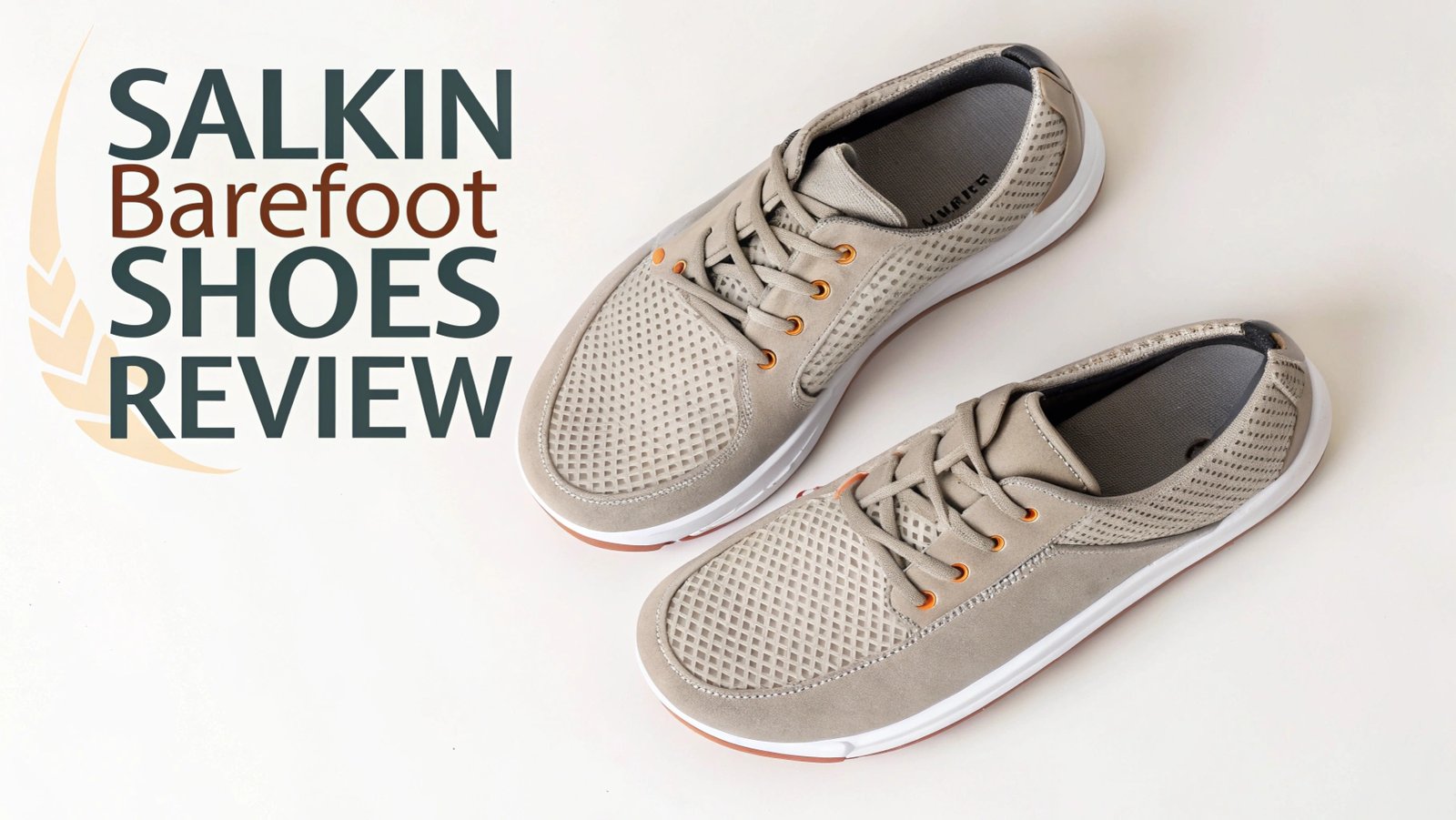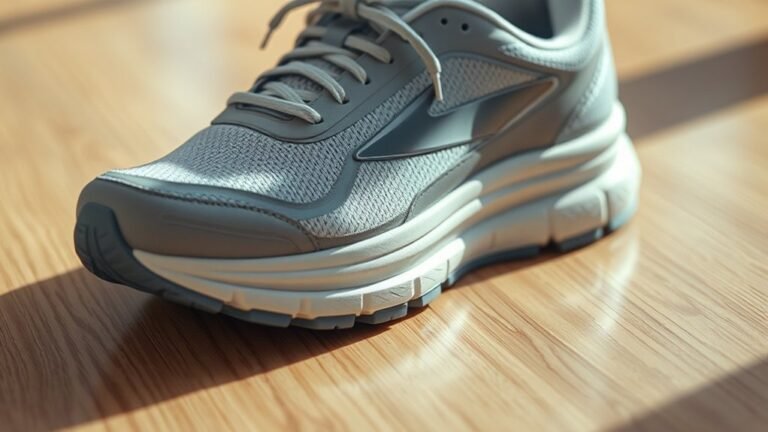Salkin Barefoot Shoes Review: Are They Worth Your Money in 2025?
The footwear industry has seen a remarkable shift toward minimalist and barefoot shoes in recent years. These shoes aim to mimic the natural feeling of walking barefoot while providing essential protection.
Salkin barefoot shoes have emerged as a popular option in this growing market. This review dives deep into what makes Salkin barefoot shoes stand out, their benefits, potential drawbacks, and whether they deserve a place in your shoe collection.
If you have been curious about trying barefoot shoes or specifically interested in the Salkin brand, this comprehensive review will help you make an informed decision about whether these shoes align with your lifestyle and needs.

Key Takeaways
- Salkin barefoot shoes feature a zero-drop design that promotes natural foot movement and proper posture alignment
- They are made with recycled faux leather materials and have waterproof lining for durability in various environments
- The shoes offer a wide toe box that allows toes to spread naturally during walking and standing
- Salkin barefoot shoes provide good ground feel while still offering some cushioning for beginners
- The flexible rubber sole allows feet to move naturally while providing grip on different surfaces
- These shoes are suitable for daily wear and light trail activities but may not be ideal for rough terrain
- Users report improved balance and posture after transitioning to Salkin barefoot shoes
- Some customers note that the sizing runs slightly larger than standard shoe sizing
- The shoes feature a slip-on design with pull-on closure for easy wearing
- Transitioning to barefoot shoes requires a gradual approach to avoid foot discomfort or injury
- Salkin barefoot shoes are reasonably priced compared to other barefoot shoe brands on the market
- The shoes come in various colors and styles to suit different preferences and occasions
What Are Barefoot Shoes?
Barefoot shoes represent a fundamental shift in footwear philosophy. Unlike traditional shoes with thick cushioning, arch support, and elevated heels, barefoot shoes aim to let your feet function as nature intended. True barefoot shoes share several key characteristics that set them apart from conventional footwear.
The most noticeable feature is the zero-drop design, meaning there is no height difference between the heel and toe areas. This encourages a more natural foot position and gait pattern. Barefoot shoes also feature a minimal sole thickness that allows you to feel the ground beneath your feet while still providing protection from sharp objects and extreme temperatures.
Another essential element is the wide toe box that gives your toes room to spread and grip naturally when walking. This contrasts sharply with the pointed or narrow toe boxes found in many conventional shoes that can compress toes together and potentially lead to issues like bunions.
Barefoot shoes are also highly flexible, allowing your foot to bend and move without restriction. This flexibility helps strengthen the small muscles in your feet that may become weak and underdeveloped in rigid, supportive shoes. The lightweight construction of barefoot shoes reduces fatigue during long periods of wear and makes movement more efficient.
The philosophy behind barefoot shoes is backed by growing research suggesting that allowing feet to function naturally can lead to stronger feet, improved balance, and potentially fewer injuries. The human foot contains 26 bones, 33 joints, and over 100 muscles, tendons, and ligaments—all designed to work together in a specific way that conventional shoes often inhibit.
The Salkin Barefoot Shoes Brand
Salkin has positioned itself as an accessible option in the barefoot shoe market. The brand focuses on creating shoes that balance the benefits of barefoot design with comfort features that make them approachable for newcomers to minimalist footwear.
The company offers various models including casual everyday shoes, trail boots, and lightweight mesh options. The brand appears to be sold through multiple retailers including Moving Steps, Amazon, and other online platforms.
What makes Salkin stand out from other barefoot shoe brands is their focus on affordability without compromising on essential barefoot features. While premium barefoot shoe brands often charge $100-200 per pair, Salkin models typically range from $65-85, making them more accessible to those wanting to try barefoot shoes without a significant financial investment.
Salkin barefoot shoes are made with durable recycled faux leather for many of their models, appealing to environmentally conscious consumers. They also feature waterproof lining in some models, making them suitable for various weather conditions. The company emphasizes both functionality and style in their designs, creating shoes that don’t immediately stand out as “alternative” footwear.
The brand appears to be gaining traction in the barefoot community, with increasing mentions on forums and review sites. While not as established as pioneer brands like Vivobarefoot or Xero Shoes, Salkin is carving out its niche as a value-oriented option in the growing barefoot shoe market.
Design and Construction of Salkin Barefoot Shoes
Salkin barefoot shoes feature a thoughtful design that balances minimalist principles with practical features. The shoes have a sleek, casual appearance that doesn’t immediately signal they’re barefoot shoes, making them versatile for different settings from office environments to casual outings.
The upper portion of most Salkin models is constructed from recycled faux leather that provides durability while reducing environmental impact. This material has a supple feel but still offers structure to the shoe. Some models feature mesh sections that enhance breathability, keeping feet cool during extended wear or in warmer climates.
A key aspect of the construction is the waterproof lining found in many Salkin shoes. This feature sets them apart from some barefoot competitors, as it allows the shoes to perform well in wet conditions without compromising the barefoot feel. The lining helps prevent water penetration while still allowing feet to breathe.
The sole construction follows barefoot principles with a zero-drop design and flexible rubber material. The soles are thin enough to provide ground feedback but thick enough to protect from sharp objects. The sole features patterns that provide grip on various surfaces, enhancing stability without adding unnecessary bulk.
Many Salkin models feature a slip-on design with pull-on closure, making them convenient for quick wear. This design eliminates the need for laces while still providing a secure fit. The interior includes a cushioned insole that can be removed for those wanting a more direct ground connection as they advance in their barefoot journey.
The shoes feature a wide toe box that allows toes to spread naturally, though some users note it’s not as wide as some dedicated barefoot brands. The overall construction prioritizes flexibility, allowing the foot to move and bend naturally through the walking gait cycle.
Comfort and Fit Experience
The comfort experience of Salkin barefoot shoes strikes a balance that makes them particularly suitable for those transitioning from conventional footwear. The shoes offer immediate comfort for most users without the extreme adjustment period sometimes required with ultra-minimalist options.
New wearers often comment on the lightness of the shoes compared to traditional footwear. Weighing significantly less than conventional shoes, Salkin models reduce fatigue during all-day wear. The flexible sole moves with your foot rather than against it, eliminating the stiffness that can cause discomfort in regular shoes.
The zero-drop platform feels natural to many users after a brief adjustment period. This design aligns the foot in a natural position and can help reduce pressure on knees and hips for some wearers. The moderate cushioning provides enough impact absorption for comfort on hard surfaces like concrete without completely isolating you from ground feedback.
Regarding fit, multiple reviews mention that Salkin shoes tend to run slightly larger than standard sizing. This is actually beneficial for barefoot shoes, as it provides ample room for toes to spread naturally. The wide toe box accommodates various foot shapes, though some users with particularly wide feet may find them still slightly constraining compared to specialized wide-fit barefoot brands.
The slip-on design with elasticized openings makes for easy on and off while maintaining a secure fit during activity. The interior of the shoe features smooth seams that reduce friction points and potential irritation during extended wear. The cushioned insole provides initial comfort but can be removed for a more authentic barefoot experience as feet strengthen.
Temperature regulation is another comfort factor worth noting. The breathable materials help prevent overheating and moisture buildup, though the waterproof models may be less breathable than the mesh versions in very hot conditions.
Performance in Different Activities
Salkin barefoot shoes demonstrate versatile performance across various activities, though they have clear strengths and limitations depending on the context. Understanding where they excel helps set appropriate expectations for these shoes.
For daily walking and casual wear, Salkin barefoot shoes perform exceptionally well. The flexible sole and zero-drop design promote natural gait patterns while providing sufficient protection for urban environments. Users report comfortable all-day wear for activities like shopping, commuting, and general daily movement. The casual styling makes them appropriate for many social and professional settings where more extreme-looking barefoot shoes might stand out.
When it comes to light hiking and trail use, the Salkin 2.0 Trail Barefoot Boots version offers adequate performance on well-maintained paths. The enhanced grip pattern on these models provides traction on varied terrain, while the water-resistant upper keeps feet dry in morning dew or light rain. However, some users note that the sole thickness is insufficient for rocky or very uneven terrain, where sharp objects can be felt too intensely through the bottom.
For fitness activities, experiences vary based on the specific exercise. The shoes work well for gym sessions focused on lifting weights, where the flat sole creates a stable platform. They also perform adequately for bodyweight exercises and low-impact training. However, for activities involving lateral movements or high impact, such as intense plyometrics or court sports, they may not provide enough structure or support for some users.
Regarding running performance, Salkin shoes can accommodate short to moderate distances for experienced barefoot runners. The flexible sole allows for natural foot movement through the running gait. However, they lack some of the specialized features found in dedicated barefoot running shoes, such as enhanced durability in high-wear areas or running-specific tread patterns. Beginners to barefoot running should transition very gradually if using these shoes.
For travel, Salkin shoes earn high marks for their lightweight design and versatility. They pack flat and take up minimal suitcase space. Their casual styling works across multiple settings, potentially reducing the number of shoes needed for a trip. The slip-on design makes them convenient for airport security lines and quick transitions.
Health Benefits of Barefoot Shoes
The transition to barefoot shoes like Salkin can offer numerous potential health benefits, supported by both scientific research and user experiences. These benefits stem from allowing feet to function more naturally rather than being constrained and supported by conventional footwear.
One of the most significant benefits is foot strengthening. Traditional shoes with arch support and cushioning can weaken foot muscles over time as they do the work that your muscles should be doing. Barefoot shoes allow the intrinsic foot muscles to engage and strengthen with each step. Users often report feeling their feet become more robust and resilient after months of barefoot shoe wear.
Comparing Salkin to Other Barefoot Brands
The barefoot shoe market has expanded significantly in recent years, with numerous brands offering their take on minimalist footwear. Understanding how Salkin compares to other options helps contextualize their value proposition and identify their unique place in the market.
In terms of price point, Salkin positions itself in the mid to low range of the barefoot market. With most models priced between $65-85, they’re significantly more affordable than premium brands like Vivobarefoot ($150-200) and somewhat less expensive than mid-range options like Xero Shoes ($80-130). This accessibility makes them an attractive entry point for those curious about barefoot shoes without wanting to make a major investment.
Regarding sole thickness, Salkin offers what might be considered a moderate barefoot experience. Their soles provide more ground feel than transitional minimalist shoes but offer more cushioning than ultra-minimal options. This places them in a sweet spot for beginners or those who need some shock absorption while still wanting barefoot benefits.
The durability comparison shows Salkin performing reasonably well for their price point. While they may not match the longevity of premium barefoot shoes with specialized high-abrasion materials, user reviews suggest they hold up adequately under normal use. The recycled faux leather upper maintains its appearance well, though the sole may wear faster than more expensive competitors with specialized rubber compounds.
User Experiences and Reviews
Customer feedback provides valuable insights into the real-world performance of Salkin barefoot shoes. Reviews from various platforms reveal consistent themes about these shoes’ strengths and limitations.
Comfort receives consistently positive mentions across user reviews. Many highlight the immediate comfort without an extended break-in period. One reviewer on Moving Steps noted, “Great shoes, very comfortable,” while another on Ravello Barefoot Shoes stated, “They are very soft and comfortable. Walking with these shoes is really comfortable!!!!”
The versatility of Salkin shoes earns praise from users who appreciate their ability to function across different settings. The casual styling that doesn’t scream “barefoot shoe” allows wearers to use them in professional environments where more distinctive minimalist footwear might draw unwanted attention.
Ease of use is frequently mentioned as a strength, with the slip-on design particularly appreciated. The absence of laces makes them convenient for quick errands, travel, and daily wear. This feature combines with their lightweight nature to make them exceptionally practical everyday shoes.
The price-to-quality ratio receives positive assessment from many users who feel they offer good value compared to more expensive barefoot brands. For those new to barefoot shoes, this accessible price point reduces the financial risk of trying a different footwear approach.
However, users do note some limitations for specific uses. One customer mentioned they are “not for walking over anything but a smooth surface, sole too thin,” indicating they may not be ideal for rough terrain or trail use. This aligns with other feedback suggesting they perform best in urban environments rather than challenging outdoor settings.
Style and Versatility
The aesthetic appeal and versatility of footwear significantly influence purchasing decisions. Salkin barefoot shoes take an approach that balances minimalist function with mainstream style sensibilities.
Visually, Salkin shoes feature a clean, understated design that avoids the sometimes unusual appearance of specialized barefoot footwear. The silhouette closely resembles conventional casual shoes, with the primary visual difference being a slightly wider toe box. This subtle approach makes them versatile across various settings from casual to business casual environments.
The color options typically include neutral tones like black, brown, and blue that coordinate easily with different outfits. This practical palette enhances their versatility as everyday footwear. Some models feature subtle brand logos, but the overall aesthetic remains clean and uncluttered.
The recycled faux leather material used in many models has a premium look that belies the moderate price point. This material maintains its appearance well with basic care, contributing to the shoes’ longevity as presentable footwear. Some models incorporate mesh panels that add visual interest while enhancing breathability.
From a versatility perspective, Salkin shoes excel as crossover footwear that bridges different aspects of life. They transition seamlessly from work settings to casual outings, potentially reducing the need for multiple pairs of shoes for different activities. Their understated design makes them appropriate for most casual restaurants, offices with relaxed dress codes, travel, and everyday errands.
FAQs
Are Salkin barefoot shoes true to size?
Most users report that Salkin shoes run slightly larger than standard sizing. Consider ordering your normal size for a roomy barefoot fit or sizing down if you prefer a more snug feel.
How long do Salkin barefoot shoes typically last?
With regular use, most customers report 6-12 months of wear before noticing significant sole wear. The upper materials tend to last longer than the soles under normal conditions.
Can I run in Salkin barefoot shoes?
Short distances are possible for experienced barefoot runners, but they’re not specifically designed as running shoes. Start with walking and gradually introduce running if you’re new to barefoot movement.
Are Salkin shoes completely waterproof?
Models with waterproof lining resist water well in rain and wet conditions but are not designed for submersion or extremely wet environments.
Do Salkin barefoot shoes have arch support?
No, like true barefoot shoes they lack structured arch support to allow your foot’s natural arch to function and strengthen on its own.
How do I clean my Salkin barefoot shoes?
Wipe with a damp cloth and mild soap, then air dry away from direct heat. Remove insoles to clean and dry separately.
Are Salkin shoes suitable for wide feet?
They have a wider toe box than conventional shoes but may not accommodate extremely wide feet. Some users with moderately wide feet find them comfortable.
Can I wear Salkin barefoot shoes with orthotics?
Most models have removable insoles that can be replaced with thin orthotics, but thick custom orthotics may not fit properly and would counteract the barefoot design philosophy.
Do Salkin barefoot shoes help with plantar fasciitis?
Some users report relief, but results vary greatly. Transition very gradually if you have this condition and consider consulting a podiatrist.
Are Salkin shoes suitable for all-day standing?
Many users report comfortable all-day wear, but build up gradually if you’re new to barefoot shoes, especially for standing on hard surfaces.

Mia Smith is the founder of Shoe Storyteller, a blog that celebrates the art and stories behind shoes. With a passion for fashion and a flair for storytelling, Mia brings a unique perspective to the world of footwear.






